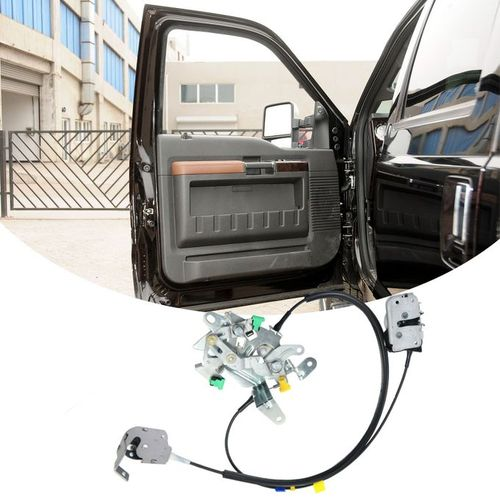Car security has evolved rapidly in recent years. With the increasing prevalence of sophisticated car theft techniques, manufacturers have turned to advanced anti-theft technologies to protect vehicles. One of the most crucial components in modern car door locks is the door lock actuator, which plays a pivotal role in ensuring your car remains secure. In this article, we'll explore the latest anti-theft technology for car door locks and delve into how door lock actuators are central to this innovation.
In the past, car door locks relied on simple mechanical keys and basic locking mechanisms. While effective at the time, these locks were prone to theft methods like lock picking and hotwiring. The introduction of electronic door lock actuators revolutionized car security, offering more sophisticated locking systems that are difficult to breach.
The door lock actuator is a motorized device responsible for engaging and disengaging the door lock electronically. Whether through a key fob, keyless entry system, or internal locking button, the door lock actuator enables secure, remote locking of your vehicle. As car theft methods evolved, so did the technology behind these actuators, making them integral to today’s anti-theft systems.
Biometric Recognition
One of the most exciting advancements in anti-theft technology is the integration of biometric recognition systems into car door locks. These systems use fingerprints, facial recognition, or even iris scans to authenticate the driver before unlocking the car. Behind this cutting-edge tech, the door lock actuator remains essential, as it receives commands from the biometric system and locks or unlocks the doors accordingly.
Keyless Entry and Push-Button Start Systems
Modern cars are increasingly equipped with keyless entry systems, where proximity sensors detect the key fob and allow entry without the need to press any buttons. Once the key fob is near, the door lock actuator responds by unlocking the doors automatically. Similarly, push-button start systems allow you to start your car without inserting a key. These systems work hand in hand with the actuator to secure the car as soon as you walk away or press the lock button on your fob.
While convenient, these systems have also attracted tech-savvy thieves who attempt to exploit relay attacks. Manufacturers, however, have responded with advanced door lock actuators that are paired with encrypted communication protocols, ensuring that the system cannot be easily hacked or manipulated.
RFID-Based Locking Systems
Radio-frequency identification (RFID) technology is another promising addition to modern vehicle security. RFID-based locks provide a layer of encryption that makes it difficult for potential thieves to replicate the signal. As with all other modern locking mechanisms, the door lock actuator is responsible for the physical locking and unlocking once the RFID tag is authenticated. This pairing enhances security by adding multiple layers of protection that are difficult to override.
Smartphone Integration
Smartphone-based car access is another area where door lock actuators shine. Newer models allow drivers to lock, unlock, and even start their cars remotely using a mobile app. This innovation is not only convenient but also enhances security through the use of two-factor authentication, GPS tracking, and encrypted connections. The door lock actuator is the final piece of the puzzle, performing the physical action based on commands received from the smartphone.
Anti-Tampering Sensors
A major improvement in car door locks is the use of anti-tampering sensors. These sensors detect any suspicious activity, such as forced entry attempts, and immediately engage the car's security system. The door lock actuator plays a crucial role here by either locking or immobilizing the car in response to the signals from the sensors. This ensures that even if thieves try to tamper with the physical lock, they won't be able to gain access easily.
Encrypted Door Lock Actuators
Modern door lock actuators are increasingly equipped with encryption to prevent hackers from accessing the vehicle's central locking system. These actuators use encrypted communication channels to ensure that any commands sent to the actuator are verified and secure. Without proper authentication, the actuator will not respond, adding a strong layer of protection against cyber-attacks.

At the heart of all these innovations is the door lock actuator, the unsung hero of vehicle security. The actuator ensures that any command, whether from a key fob, biometric scanner, or smartphone app, is translated into a physical action – locking or unlocking the doors. Without a reliable door lock actuator, even the most advanced anti-theft systems would fail to secure your car effectively.
The reliability and strength of the door lock actuator are paramount, as it must operate under various conditions, from extreme heat to freezing temperatures. With the rise of electric vehicles (EVs), manufacturers are also focusing on developing actuators that consume less power, extending battery life while maintaining security.
As car theft techniques become more advanced, car manufacturers and technology developers are constantly innovating to stay one step ahead. The future of car door locks will likely see even more sophisticated door lock actuators, integrating artificial intelligence, enhanced encryption, and smart sensors to provide an unbeatable layer of security.
For example, AI-enabled door lock actuators could learn the owner’s habits, adjusting the sensitivity of the system based on usual behaviors. Meanwhile, future encryption techniques may make it virtually impossible for even the most experienced hackers to breach the car’s security.
In conclusion, the role of the door lock actuator in modern anti-theft systems cannot be overstated. As technology evolves, so too does the importance of actuators in protecting vehicles from theft. From biometric systems to RFID locks and smartphone integration, the door lock actuator is at the center of it all, ensuring that no unauthorized individual can access your car. As manufacturers continue to innovate, we can expect the next generation of door lock actuators to be smarter, more secure, and more integral to vehicle security than ever before.
By understanding the vital role that door lock actuators play, car owners can appreciate how their vehicles are better protected than ever against theft.
GET A QUOTE